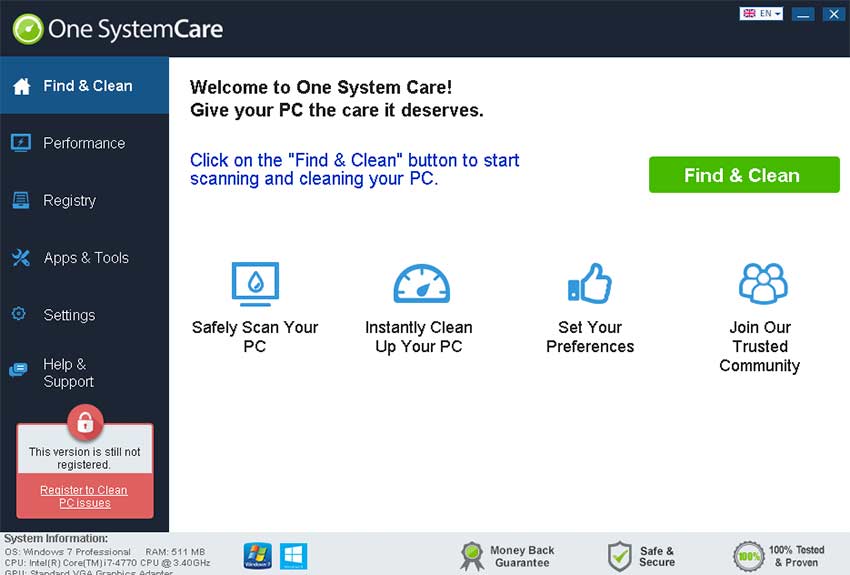I wrote this article to help you remove Grato. This Grato removal guide works for all Windows versions.
Grato is a program which provides security maintenance services. The functions of the tool include protection, scanning, an optimizer, an app manager and an app lock. Grato has the user interface of a professional security tool. However, experts have given the utility a different evaluation. Grato has been categorized as a potentially unwanted program (PUP). The shady software has been found to conduct unauthorized tasks. The operations Grato carries out bring down the system’s security level, rather than enhance it. This application should not be allowed on your computer.
Granted, you may not have installed Grato to your system. If this is the case, we can explain how the PUP was able to penetrate your machine undetected. Grato uses a couple of propagation vectors. The preferred distribution method is bundling. The covert program can travel in a merged setup file with another application. Freeware, shareware and pirated tools are used to host Grato, since their lack of license allows them to be exploited. The PUP gets included as a bonus with the main software. It will be mentioned in the end use license agreement (EULA) and selected per default. You have to find the option and change the setting. If you do not, the PUP will get the green light. Make sure you read the terms and conditions of the programs you install to your system.
The other way for Grato to sneak into your machine undetected is through a spam email. The sender behind the bogus message will use a file to execute the transferal. The PUP will be hidden behind a document, presented as a receipt, an invoice, a bill, a fine, a subpoena or something else you would find important. Opening the attachment may be enough to initiate the download and install of Grato. We advice users to proof the reliability of each and every single letter from their in-box. Check the email address and other provided contacts. In many instances, spam messages are sent on behalf of entities, rather than people. First of all, check if the organization exists. If it is legitimate, go to its official website and consult the contacts page.

The main activity on the agenda of Grato is to display ads. The clandestine program will try to make you believe your system is in need of repair. It will show you messages, urging you to conduct scans and clean your hard drive from unnecessary files. Deleting temporary files and other excess data is indeed recommended. However, not as often as the rogue program will advice you to. Furthermore, Grato is not the best tool for the job. The disk cleanup function is enough to keep your OS running at optimal efficiency.
The notifications which urge users to run maintenance operations are not the only types of ads Grato displays. The PUP also generates commercial advertisements. It shows offers for various items, like technological devices, clothes, furniture, accessories, sports gear, gardening equipment, games, toys and many others. The product offerings may acquire your interest, as Grato focuses on bargain deals. Keep in mind that the utility is not stated to provide online shopping services. If a program branches out to tasks it is not supposed to perform, there is probably a catch. In this instance, the issue is that Grato does not take responsibility for the websites it supports. Clicking on an ad could take you to a corrupted domain, resulting in an infection. The owners of the PUP have decided not to disclose their identity and not to list contacts. The burden of the security risk is assumed entirely by the end user.
Grato also poses a personal security risk. The sinister program collects information on users, such as their browsing history, IP address, geographic location, tracking cookies, keystrokes, email account, telephone number, user names, passwords and financial details. The gathered data is sold on darknet markets without authorization. Your sensitive details could fall into the hands of cyber criminals. The consequences depend on the types of information you have disclosed through your online activity. If you have banking, credit card or other financial accounts, the crooks could steal your funds.
Grato Uninstall
 Run the Task Manager by right clicking on the Taskbar and choosing Start Task Manager.
Run the Task Manager by right clicking on the Taskbar and choosing Start Task Manager.

Look carefully at the file names and descriptions of the running processes. If you find any suspicious one, search on Google for its name, or contact me directly to identify it. If you find a malware process, right-click on it and choose End task.

Open Control Panel by holding the Win Key and R together. Write appwiz.cpl in the field, then click OK.

Here, find any program you had no intention to install and uninstall it.

Open MS Config by holding the Win Key and R together. Type msconfig and hit Enter.

Go in the Startup tab and Uncheck entries that have “Unknown” as Manufacturer.
Still can not remove Grato from your computer? Please, leave a comment below, describing what steps you performed. I will answer promptly.

